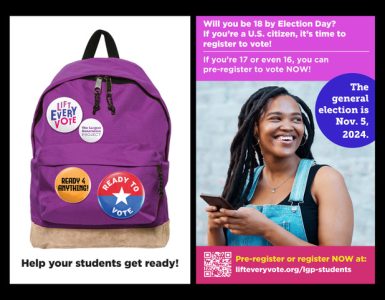Widgetized Section
Go to Admin » Appearance » Widgets » and move Gabfire Widget: Social into that MastheadOverlay zone
Gen Z Knows It’s Important to Vote but They Need Your Help Anyway
The views expressed are those of the author and do not necessarily reflect the views of ASPA as an organization.
By Kim Sullen
July 15, 2024

By far the largest and most diverse American generation, Generation Z numbers 82 million strong, with members born between 1997 and 2012. With their oldest members now 27 years old, and their youngest only twelve, this generation vastly outnumbers Baby Boomers, and they also exceed Millennials by two million. Yet despite their numbers, like generations before them, the youth electorate is once again the smallest group of voters.
This is not to say Gen Z is apathetic; on the contrary, they have voted in record numbers compared to past youth voter turnouts. According to Tufts University’s Center for Information & Research on Civic Learning and Engagement (CIRCLE), the number of young people ages 18-29 who showed up for the 2018 midterm election more than doubled from the 2014 midterms, bringing the numbers from 13 percent up to 28 percent. CIRCLE also determined that 50 percent of young people cast a ballot in the 2020 general election, again drastically increasing the youth voting rate up from 39 percent in 2016.
While these numbers taken out of context may not be staggering, they hint at the inaccuracy of the premise that a generational lack of interest keeps young citizens from the polls. In their book Making Young Voters, researchersJohn B. Holbein and D. Sunshine Hillygus make the case that teens of voting age and young twenty-somethings do not need to be persuaded to vote, but rather they need tangible support to follow through with their sincere intentions to cast a ballot. The authors attribute the failure of many young people to overcome the obstacles of voting due to a lack of non-cognitive skills. Simply stated, many young would-be voters lack the grit and tenacity to rise above the quandaries that may pop up on the path from registering to actually voting.
Holbein and Hillygus give examples of hurdles that throw young voters off track, such as showing up at a poll site and finding their name is not on the voter rolls, unexpected long lines, figuring out when and how to vote and finding transportation to the polling site. Discomfort with the unknown also deters young people. While many believe that the basics of voting are discussed in most secondary institutions, this is not the case at all.
There is some surprisingly good news amidst these pitfalls on the path to voting, though. Holbein and Hillygus demonstrate that preregistration—which is legal in the majority of states before would-be voters are 18—boosts the probability of people ages 18-22 casting a vote by 13 percent. Incredibly, very few state or local governments publicize the availability of preregistration, resulting in the unsurprising fact that relatively few teens know it exists or how to use it.
Perhaps recognizing that failing to inform youth about voting erodes democracy, New York State passed Bill S1733A this year, requiring schools to help students get pre-registered and registered to vote. While this is promising, and some other states have similar initiatives, the implementation of this law is murky only months away from the 2024 general election.
Though many high school teachers might welcome the opportunity to teach their students about voting, others feel overloaded with their basic requirements, and still others resist even broaching the subject of politics, due to state or community pressures. This is where volunteerism can make a difference:
Reach out to your local high school(s) and elected officials. If your local school is willing to distribute voter registration forms to students but doesn’t currently distribute them, you can help by obtaining bulk quantities. Contacting an elected official who you know can be helpful in securing them for the school. Otherwise, contact your Board of Elections and find out if and how you can secure the number of forms that the school needs.
Show up as part of a voting advocacy organization, or bring someone who is. You or your contact can run a class or workshop for high school students, focusing on what they need to register (or preregister) in your state, along with the basic mechanics of voting. Sometimes adults forget that simple but foreign tasks can be intimidating for even the brightest teens!
Help the high schoolers you know organize. You can help them organize a voting registration drive at their school. There are resources available to help, including the youth-led organization TurnUp, which even pays high school students in selected states an honorarium to lead registration drives.
Above all, talk with the young people in your life about registering and voting. Help them feel familiar with the process and be honest about the possibility of long lines or other challenges. It’s not uncommon for teens to feel that they don’t deserve to have a vote, because of their own perceptions that they aren’t well enough informed about issues or the candidates. It’s essential to assure them that their own critical evaluations of what candidates say and do are as valid as those of more experienced Americans.
Voting habits have staying power and are formed when people are young. If we want the largest generation to be an active electorate when they’re older, we need to help ensure young people embark on the path now.
Author: Kim Sillen is the Deputy Director of Creative Service at NYC DOT. She cofounded The Largest Generation (now See Gen Z Vote), a youth voter advocacy internship for college students in 2020, which created digital campaigns and infographics for colleges and organizations across the U.S. that were looking to reach potential Gen Z voters. More recently, she partnered with Lift Every Vote, which utilized her research on preregistration. [email protected]


Follow Us!